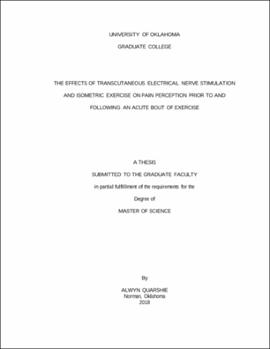| dc.description.abstract | Pain is defined as an unpleasant sensory or emotional experience. The experience of acute or chronic pain has produced adverse societal implications. The use of exercise and TENS have been established for their ability to modulate pain. PURPOSE: The purposes of this study were to investigate the effect of TENS and isometric exercise in concert or individually on responses to pressure pain; and explore the differences in pain responses when exercise is voluntary or involuntary. METHODS: Sixteen female participants completed familiarization and 5 experimental visits. Pressure pain thresholds (PPT) were assessed prior to each treatment and immediately post (iPost), 10 minutes (10-min Post) and 20 minutes (20-min Post) post treatment. The first experimental visit required completion of a voluntary isometric task. The second visit evoked a similar isometric task using neuromuscular stimulation. The third visit combined TENS and the same voluntary isometric task. Visits four and five involved application of TENS for 20 minutes and a time matched duration respectively. All testing visits were randomized with the exception of the first experimental visit. One-way repeated measures ANOVAS were conducted to assess differences in pain sensitivity following each treatment followed by post-hoc testing using Fisher’s LSD. Multi-factorial ANOVA was conducted to examine treatment interactions across treatments, muscle groups, and time points followed by Fisher’s LSD to examine differences in significant one-way ANOVA. RESULTS: Participants pressure pain thresholds (PPT) increased following the voluntary isometric task in the contracting vastus lateralis (VL), iPost (p = 0.01) and 10-min Post (p= 0.047) and brachioradialis iPost (p = 0.002). PPTs were significantly increased following neuromuscular stimulation in the contracting VL iPost (p<0.001) and 10-min Post (p = 0.042) and only iPost (p = 0.016) in the brachioradialis. PPTs were significantly increased following voluntary isometric exercise + TENS in the contracting VL iPost (p = 0.001) and 10-min Post (p = 0.013); in the contralateral VL iPost (p = 0.002), 10-min Post (p = 0.012), and 20-min Post (p = 0.003); in the brachioradialis iPost (p = 0.005), 10-min Post (p = 0.033), and 20-min Post (p= 0.017). Following TENS for 20 minutes PPTs were significantly higher in the contralateral VL iPost (p = 0.045) and 10-min Post (p = 0.046). Following time matched TENS PPTs were significantly higher in the contralateral VL iPost (p < 0.001), 10-min Post (p = 0.018), and 20-min Post (p = 0.005); in the brachioradialis iPost (p = 0.002), 10P (p = 0.001), and 20-min Post (p = 0.009). The magnitude of the hypoalgesic response from all treatments showed a significant decrease in pain sensitivity in the contracting VL iPost (p < 0.001) treatment compared to 10-min Post and 20-min Post treatment. CONCLUSIONS: No single treatment seemed to elicit a higher hypoalgesic response than another. Additionally, the magnitude of response to any treatment was most robust iPost treatment in the contracting VL and was not sustained. Further studies should combine high frequency TENS applied at multiple sites. A larger sample size would also be beneficial. | en_US |
